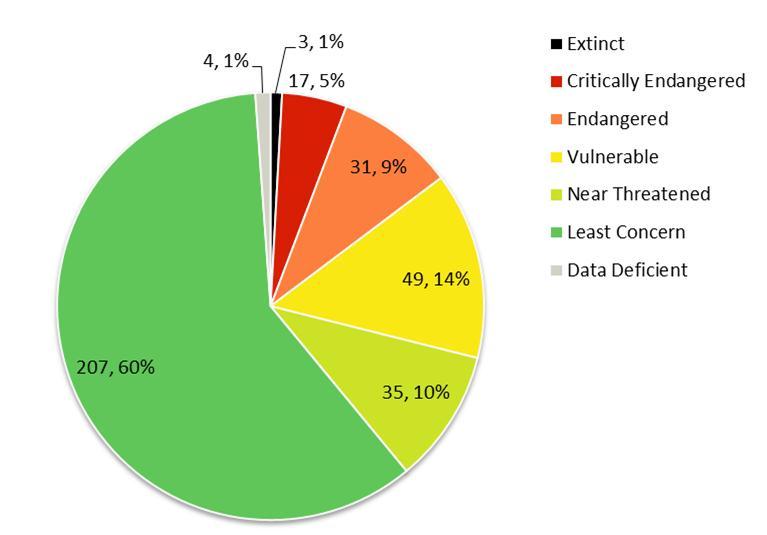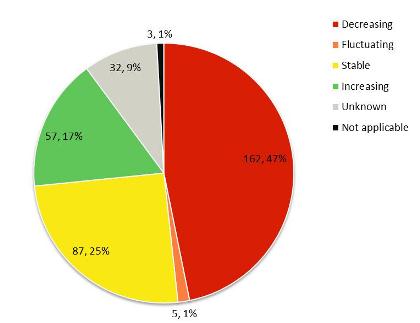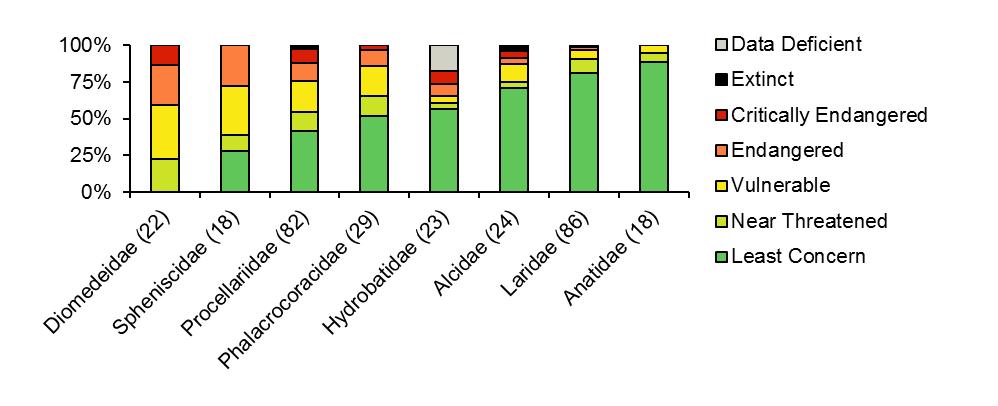|
Seabirds are a taxonomically varied group of nearly 350 bird species (around 3.5% of all birds) that depend on the marine environment for at least part of their life cycle. They are typically apex-predators within the oceanic food chain and, consequently, key indicators of wider marine health. Over recent decades, the status of the world’s seabirds has deteriorated, with several species slipping close to extinction. Human activities lay behind these declines—the introduction of invasive species has had a catastrophic impact on many breeding colonies, whilst overfishing has degraded the marine environment and caused the deaths of innumerable seabirds through accidental bycatch. Thankfully, there is mounting global recognition of the problem and around the world the BirdLife Partnership is working to ensure that concrete actions are taken to safeguard seabirds. |
Marine environments cover more than 70% of the Earth’s surface and are vital to sustaining life. The oceans govern global climate and weather patterns and, through the activities of microscopic photosynthesising organisms, help create and maintain the planet’s atmosphere. Despite the pivotal significance of marine ecosystems, our knowledge of them remains poor. Seabirds are a conspicuous part of the marine realm and compared to other major groups of marine organism are exceptionally well-studied. Consequently, seabirds provide a crucial window onto the condition of the oceans and are excellent indicators of its health.
 |
|
Figure 1. Proportion of seabird species in each IUCN Red List category |
 |
| Figure 2. Current direction of trend for all seabird species |
 |
| Figure 3. Percentage of species in each IUCN Red List category for the major seabird families. Number of species per family in brackets |
The IUCN Red List Index (RLI) for birds tracks the movement of species through categories of extinction risk (![]() ). It reveals that although there has been a steady deterioration in the status of birds in all regions of the world, species associated with the marine environment—especially the open ocean—have fared particularly badly (
). It reveals that although there has been a steady deterioration in the status of birds in all regions of the world, species associated with the marine environment—especially the open ocean—have fared particularly badly (![]() ,
, ![]() ). Of the 346 seabird species, 97 (28%) are globally threatened, 17 (5%) in the highest category of Critically Endangered, and a further 10% are Near Threatened (Figure 1). Nearly half (47%; 52% of those with known trends) of seabird species are known or suspected to be experiencing population declines (Figure 2). Seabirds are thus more threatened than all other groups of birds with similar numbers of species: 26% of parrots (Psittacidae; 374 species), 19% of pigeons/doves (Columbidae; 318 species), and 18% of raptors (Accipitridae; 238 species) are threatened (
). Of the 346 seabird species, 97 (28%) are globally threatened, 17 (5%) in the highest category of Critically Endangered, and a further 10% are Near Threatened (Figure 1). Nearly half (47%; 52% of those with known trends) of seabird species are known or suspected to be experiencing population declines (Figure 2). Seabirds are thus more threatened than all other groups of birds with similar numbers of species: 26% of parrots (Psittacidae; 374 species), 19% of pigeons/doves (Columbidae; 318 species), and 18% of raptors (Accipitridae; 238 species) are threatened (![]() ,
, ![]() ). The most threatened seabirds groups are the Sphenisciformes (penguins) and Procellariiformes (albatrosses and petrels). The albatross family (Diomedeidae) is especially imperilled—for long-lived, slow-breeding species, even quite small increases in mortality can lead to significant population declines (figure 3) (
). The most threatened seabirds groups are the Sphenisciformes (penguins) and Procellariiformes (albatrosses and petrels). The albatross family (Diomedeidae) is especially imperilled—for long-lived, slow-breeding species, even quite small increases in mortality can lead to significant population declines (figure 3) (![]() ).
).
Certain countries—often those with large Economic Exclusion Zones (EEZs)—are particularly important for seabirds. These include the USA, Canada, Russia, Australia, New Zealand, Chile, South Africa and—when Overseas Territories are included—the UK and France. The highest densities of threatened seabirds are found in international waters in the southern oceans, with a particular concentration around New Zealand (![]() ).
).
Commercial fisheries are the most serious threat facing the world’s seabirds. Accidental bycatch affects 41% of threatened species (40 species) and each year longline (![]() ), trawl (
), trawl (![]() ) and gillnet (
) and gillnet (![]() ) fisheries are responsible for the incidental deaths of hundreds of thousands of seabirds. For several species of albatross, this level of mortality is unsustainable and they are now perilously close to extinction. In addition, the negative impact of overfishing on seabirds continues to increase as fisheries target ever smaller fish (
) fisheries are responsible for the incidental deaths of hundreds of thousands of seabirds. For several species of albatross, this level of mortality is unsustainable and they are now perilously close to extinction. In addition, the negative impact of overfishing on seabirds continues to increase as fisheries target ever smaller fish (![]() ).
).
The most pervasive threat to seabirds is invasive species, which adversely affect 75% of all threatened species (73 species)—nearly twice as many as any other single threat. For example, the introduced House Mouse Mus musculus is devastating seabird populations on Gough Island in the Southern Atlantic. Among the affected species are the Critically Endangered Tristan Albatross Diomedea dabbenena and the Endangered Atlantic Petrel Pterodroma incerta (![]() ). Other significant threats include pollution (
). Other significant threats include pollution (![]() ,
, ![]() ), hunting and trapping and energy production and mining (
), hunting and trapping and energy production and mining (![]() ). Climate change is already having a notable impact on the world’s oceans—disrupting the complex oceanographic phenomena and cycles that govern marine ecosystems. Declines in seabird populations off southern California suggest that these changes may be having a profound effect on marine life (
). Climate change is already having a notable impact on the world’s oceans—disrupting the complex oceanographic phenomena and cycles that govern marine ecosystems. Declines in seabird populations off southern California suggest that these changes may be having a profound effect on marine life (![]() ). Many seabirds nest on low-lying islands that could be badly impacted by rising sea levels (
). Many seabirds nest on low-lying islands that could be badly impacted by rising sea levels (![]() ).
).
Unfortunately, the behavioural and life-history traits of seabirds render them particularly vulnerable (![]() ,
, ![]() ). For long-lived, slow-breeding species, even quite small increases in mortality can lead to significant population declines. In addition, many seabirds have highly specialised diets, being reliant on just a few prey species, the abundance and distribution of which can alter dramatically in response to abrupt environmental changes.
). For long-lived, slow-breeding species, even quite small increases in mortality can lead to significant population declines. In addition, many seabirds have highly specialised diets, being reliant on just a few prey species, the abundance and distribution of which can alter dramatically in response to abrupt environmental changes.
Despite the enormity of the threats facing the world’s seabirds and the difficulties inherent in achieving conservation consensus within regions of the ocean beyond national jurisdiction, there are still numerous success stories that demonstrate that species can be saved. In Bermuda, an intensive recovery programme involving the provision of artificial nest burrows and the translocation of chicks has revived the fortunes of Bermuda Petrel Pterodroma cahow (![]() ). Similarly, conservation interventions for Zino's Petrel Pterodroma madeira and Magenta Petrel Pterodroma magenta have almost certainly prevented these species from becoming extinct (
). Similarly, conservation interventions for Zino's Petrel Pterodroma madeira and Magenta Petrel Pterodroma magenta have almost certainly prevented these species from becoming extinct (![]() ).
).
One of the main priorities for halting the declines of threatened seabirds is the control and eradication of invasive alien species. Given sufficient resources, spectacular recoveries can be achieved (![]() ,
, ![]() ). Perhaps the most ambitious eradication project to date is currently underway in the Antarctic—at 3,755 km2 South Georgia is more than seven times larger than any island where rat eradication has previously been attempted (
). Perhaps the most ambitious eradication project to date is currently underway in the Antarctic—at 3,755 km2 South Georgia is more than seven times larger than any island where rat eradication has previously been attempted (![]() ). BirdLife is currently working with Island Conservation, the University of California, Santa Cruz and a number of other organisations to compile a list of priority sites for future eradications and the provisional list for seabirds is now available (see Croxall et al. 2012).
). BirdLife is currently working with Island Conservation, the University of California, Santa Cruz and a number of other organisations to compile a list of priority sites for future eradications and the provisional list for seabirds is now available (see Croxall et al. 2012).
Effective conservation depends on targeting those species and habitats of greatest importance and most immediate risk. To this end, the identification of Important Bird Areas (IBAs) on land has been a huge success—helping focus conservation energies and inform the designation of protected areas (![]() ). Now efforts are underway to develop the first comprehensive assessment of IBAs on the high seas (
). Now efforts are underway to develop the first comprehensive assessment of IBAs on the high seas (![]() ).
).
Ensuring effective seabird conservation requires improving and enforcing legislation, regulation and best practice standards. Over the past few decades, the world’s governments have endorsed many international agreements relevant to the conservation of marine biodiversity (![]() ). The challenge now is to harness this commitment and ensure that concrete actions are taken where they are most needed. For example, under the UN Fish Stocks Agreement, States have a duty to reduce the bycatch of albatrosses in their fisheries. Since 2004, BirdLife (especially through the ‘Save the Albatross Campaign’) has been working to help turn these commitments into action (
). The challenge now is to harness this commitment and ensure that concrete actions are taken where they are most needed. For example, under the UN Fish Stocks Agreement, States have a duty to reduce the bycatch of albatrosses in their fisheries. Since 2004, BirdLife (especially through the ‘Save the Albatross Campaign’) has been working to help turn these commitments into action (![]() ). The good news—for albatrosses, fishermen and conservationists alike—is that simple measures can reduce the bycatch of seabirds without any negative effects on fish catches. Indeed, fish catches actually increase in some cases (
). The good news—for albatrosses, fishermen and conservationists alike—is that simple measures can reduce the bycatch of seabirds without any negative effects on fish catches. Indeed, fish catches actually increase in some cases (![]() ). However, while the practical solutions exist, seabird bycatch in many fisheries remains at unsustainably high levels. Recognising the gap between knowledge, policy and actual action on the deck of fishing vessels, BirdLife’s Global Seabird Programme created the Albatross Task Force (ATF) to work directly with fishermen and raise awareness of seabird bycatch issues and the practical solutions to combat it. Since their formation in 2005, the Albatross Task Force teams have overseen dramatic reductions in the numbers of albatrosses and other seabirds killed in the bycatch 'hotspots' of southern Africa and South America (
). However, while the practical solutions exist, seabird bycatch in many fisheries remains at unsustainably high levels. Recognising the gap between knowledge, policy and actual action on the deck of fishing vessels, BirdLife’s Global Seabird Programme created the Albatross Task Force (ATF) to work directly with fishermen and raise awareness of seabird bycatch issues and the practical solutions to combat it. Since their formation in 2005, the Albatross Task Force teams have overseen dramatic reductions in the numbers of albatrosses and other seabirds killed in the bycatch 'hotspots' of southern Africa and South America (![]() ).
).
|
|
|
Febuary 2012 sees the publication of a major seabird review in Bird Conservation International, the official journal of BirdLife International. The review, as well as a number of other seabird and marine themed papers, is freely available online;
|
|||
To access more case studies on seabirds and the marine environment, please click on the following links.
Links
Global Seabird Programme
Compiled 2012
Recommended citation
BirdLife International (2012) Spotlight on seabirds. Presented as part of the BirdLife State of the World's Birds website. Available from: https://datazone.birdlife.org/sowb/spotseabirds